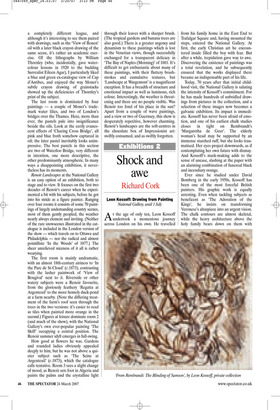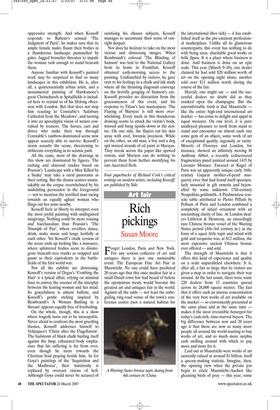Shock and awe
Richard Cork
Leon Kossoff: Drawing from Painting National Gallery, until 1 July
At the age of only ten, Leon Kossoff undertook a momentous journey across London on his own. He travelled from his family home in the East End to Trafalgar Square and, having mounted the steps, entered the National Gallery. At first, the early Christian art he encountered inside filled the boy with fear. But after a while, trepidation gave way to awe. Discovering the existence of paintings was a total revelation, and he subsequently ensured that the works displayed there became an indispensable part of his life.
Today, 70 years after that initial childhood visit, the National Gallery is saluting the intensity of Kossoff’s commitment. For he has made hundreds of unbridled drawings from pictures in the collection, and a selection of these images now becomes a galvanic exhibition. Its impact is immediate. Kossoff has never been afraid of emotion, and one of his earliest chalk studies closes in tight on Rembrandt’s ‘Margaretha de Geer’. The elderly woman’s head may be supported by an immense starched ruff, but she looks traumatised. Her eyes project downwards, as if contemplating her own future with dismay. And Kossoff’s mark-making adds to the sense of unease, slashing at the paper with an alarming combination of funereal black and incendiary orange.
Ever since he studied under David Bomberg in the early 1950s, Kossoff has been one of the most forceful British painters. His graphic work is equally arresting. Even when tackling subjects as beneficent as ‘The Adoration of the Kings’, he insists on transforming Veronese’s altarpiece into an urgent vision. The chalk contours are almost skeletal, while the heavy architecture above the holy family bears down on them with oppressive strength. And when Kossoff responds to Rubens’s sensual ‘The Judgment of Paris’, he makes sure that its ample female nudes flaunt their bodies in a thunderous landscape pummelled by gales. Jagged branches threaten to impale the woman rash enough to stand beneath them.
Anyone familiar with Kossoff’s painted work may be surprised to find so many landscapes in this exhibition. He is, after all, a quintessentially urban artist, and a monumental painting of Hawksmoor’s great Christchurch in Spitalfields is included here to remind us of his lifelong obsession with London. But that does not stop him reacting to Constable’s ‘Salisbury Cathedral from the Meadows’, and turning it into an apocalyptic vision of nature convulsed by tremors. The horses, cart and driver who make their way through Constable’s rainbow-dominated scene now appear scarcely able to survive. Kossoff’s storm assaults the scene, threatening to obliterate everything in its seismic path.
All the same, most of the drawings in this show are dominated by figures. The etching and charcoal studies based on Poussin’s ‘Landscape with a Man Killed by a Snake’ may take a rural panorama as their setting. But the drama centres unmistakably on the corpse overwhelmed by his undulating persecutor in the foreground — not to mention the terrified man racing towards an equally aghast woman who flings out her arms nearby.
Kossoff feels at liberty to interpret even the most joyful painting with undisguised misgivings. Nothing could be more rousing and bacchanalian than Poussin’s ‘The Triumph of Pan’, where revellers dance, drink, make music and lunge lustfully at each other. Yet Kossoff’s chalk version of the scene ends up looking like a massacre, where splintered bodies seem to disintegrate beneath tree trunks as stripped and gaunt as their equivalents in the battlefields of the first world war.
Not all the exhibits are distressing. Kossoff’s version of Degas’s ‘Combing the Hair’ is a lyrical affair, relying on minimal lines to convey the essence of the interplay between the leaning woman and her maid. Its gracefulness is almost balletic, and Kossoff’s gentle etching inspired by Rembrandt’s ‘A Woman Bathing in a Stream’ appears equally free of foreboding.
On the whole, though, this is a show where tragedy turns out to be inescapable. Never afraid to confront the most gruelling themes, Kossoff addresses himself to Velázquez’s ‘Christ after the Flagellation’. The hailstorm of black chalk hurling itself against the limp, exhausted body emphasises that his suffering is far from over, even though he turns towards the Christian Soul praying beside him. As for Goya’s paintings of the ‘Inquisition and the Madhouse’, their luminosity is replaced by overcast visions of hell. Although Goya could never be accused of sanitising his chosen subjects, Kossoff manages to accentuate their sense of outright despair.
Nor does he hesitate to take on the most vicious and distressing images. When Rembrandt’s colossal ‘The Blinding of Samson’ was lent to the National Gallery from its home in Frankfurt, Kossoff obtained early-morning access to the painting. Undisturbed by visitors, he gave vent to his feelings in a chalk and ink study where all the thrusting diagonals converge on the horrific gouging of Samson’s eye. Kossoff provides no distraction from the gruesomeness of this event, and his response to Titian’s late masterpiece ‘The Flaying of Marsyas’ is still more overwhelming. Every mark in this thunderous drawing seems to attack the victim’s body, trussed and hung upside-down at the centre. On one side, the flayers cut his skin away with cool, forensic precision. While on the other, an old man, a boy and a dog spit twisted strands of oil paint at Marsyas. They streak across the paper like spewed venom, and Marsyas can do nothing to prevent them from further mortifying his raw, lacerated flesh.



















































































 Previous page
Previous page